This post may contain affiliate links. If you use these links to buy something we may earn a commission. Thanks.
Zone 3 hosts a wide variety of shade-loving ground covers. In addition to loving the shade and covering the ground, the best options are tough to the swinging temperatures, adaptable, visually striking, and easy to maintain.
We’ve experimented with growing various cold-hardy ground covers in multiple types of conditions—shade being one! As a result, thistles and weeds have been replaced by a combination of useful and beautiful hardy ground covers.
If it seems that nothing grows in zone 3, it could be a placement problem. Hardy perennials that need full sun won’t grow in shade so it may not be the cold’s fault that it didn’t grow.
Related: Zone 3 Edible Plant List (Sorted By Forest Garden Layers)
Ground covers that grow well in shade will look the part—lush!
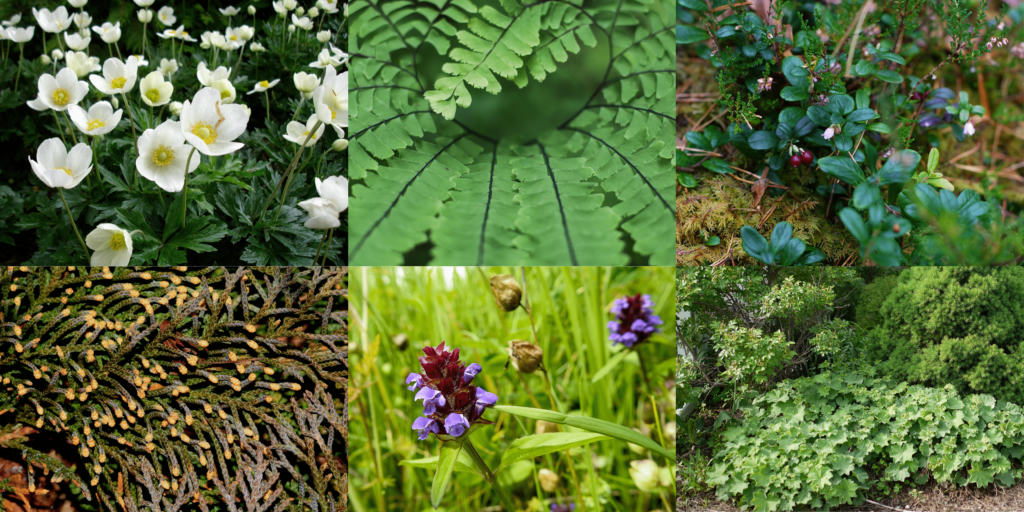
As we discover the best cold-hardy ground covers for shade we’ll provide the necessary details to help you decide which ones are best for your site (and sight!). The soil type, the volume of moisture received, and what you want from the space will be your guides when choosing.
For example:
- If the site receives very little rain you’ll have an easier time growing drought-tolerant species, and in the opposite scenario, water-loving plants. Shaded areas often retain moisture for longer than the sun, so consider how well the area drains.
Many ground covers aren’t picky about the soil type, but some will perform better or worse in clay or sand-dominant soils.
See: 16 Plants for Wet Clay Soil and Shady Areas (Confirmed)
Every space we create has a function whether we intend it or not. Are you looking for ornamental, edible, habitat, deterrent, or any other value?
See: Best Walkable Ground Covers for Shade (In Order)
Specific plants can be selected for a dominant function or a diverse mix can offer many functions as a whole unit.

To begin deciding on suitable ground covers:
- Write out the main function you want from this ground coverage and read through the descriptions of each shade-loving option below.
- To finalize your plant shopping list, refer to your local invasive species guide.
- To buy the ground covers find them as locally as possible in person or on Etsy.
You can find invasive species guides by searching “(your location) invasive plant species” or “is (plant in question) invasive in (your location).”
If you find that the “range” of any plants isn’t from your area, it doesn’t mean it is invasive. Non-native plants can be grown without being invasive. It all depends on the plant and area. So unless you’re growing a strictly native-only garden, add non-native to your list, but be sure to check and exclude any that are invasive to your area.
Here are 25 best ground covers to grow in zone 3 shade and where you can get them:
Wild Ginger (Asarum canadense)
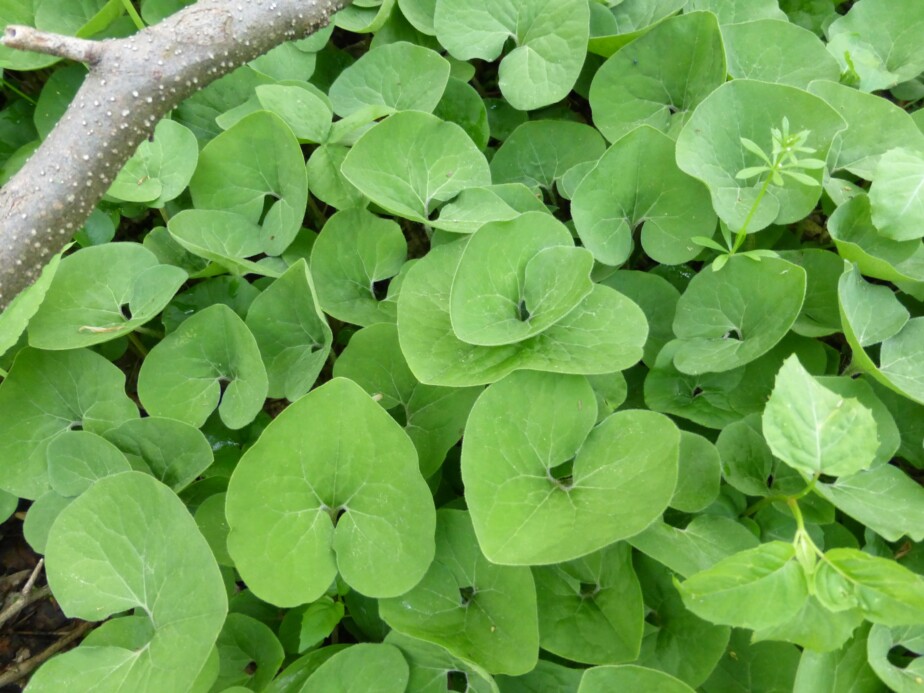
Otherwise known as ‘Candian ginger’ this wild ground cover loves shade and has various functions with blooms from April to May.
- Height: Low-growing (4-8 inches)
- Range: Native to Eastern North America
- Climate: Zones 3-8
- Functions: Roots have been used as digestive medicine. Ornamental value with shapely and lush-looking heart-like leaves. Best for ornamental-, edible-, or healing-oriented gardens.
- Light requirements: Ginger will grow as a ground cover under lightly shaded or deeply shaded areas. Partial to full shade.
- Soil preferences: Moist, drained, rich, and neutral-acidic soils.
Unless you can find someone with local cuttings to offer—Wild ginger can be bought and planted from bare roots on Etsy.
Wild or Barren Strawberry
(Fragaria virginiana or Waldsteinia fragarioides)
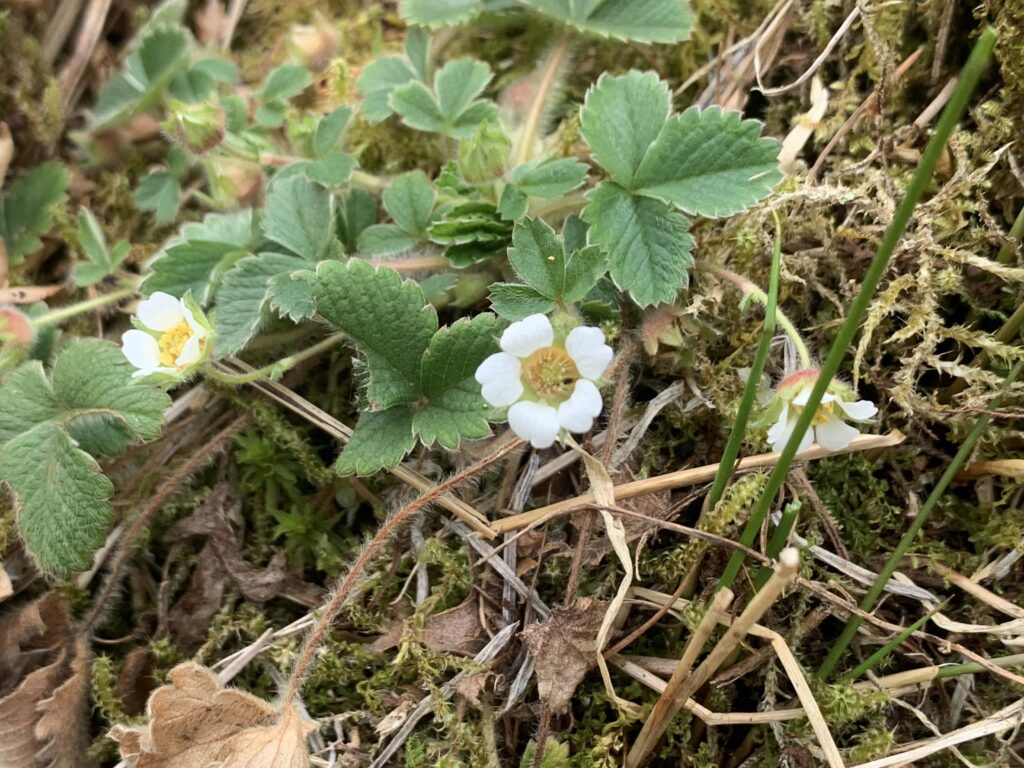
Fragaria virginiana, wild strawberries, have white flowers and fuzzy foliage, as pictured above, while Waldsteinia fragarioides, barren strawberries, have yellow flowers and glossier foliage. Like any strawberry, they spread through runners.
Wild strawberries produce small fruits and barren strawberries don’t.
The reason you should know about both, however, is that they grow and thrive a bit differently.
| Wild strawberries | Barren strawberries |
| Height: 4 inches tall. | Height: 4 inches tall. |
| Range: Native to Eastern North America. | Range: Native to Eastern North America. |
| Climate: Zone 3-7. | Climate: Hardy to zones 2 & 3 with winter mulching, or zones 4-7. |
| Functions: Spreads indefinitely and produces small and delicious edible fruit. Leaves also make a pleasant tea. | Functions: Spreads 18 inches wide with dense ground coverage. Ideal for edges and borders in general gardens as a pollinator plant. Attracts pollinators such as bees and other insects. |
| Light requirements: Grows best in partial shade or full sun. | Light requirements: Grows best in full or partial shade. |
| Soil preferences: Grows in well-drained soil and prefers moisture. | Soil preferences: Grows in well-drained soil of any type and tolerates droughts. Dry shady spots are best. |
In general, fruit-producing strawberry plants will need moisture to thrive and supply fruit. Bareen strawberries, hence the name, that don’t produce fruit won’t require moisture all the time.
The choice between strawberries as a ground cover depends on what moisture level your shady spot receives. is it generally dry? or moist most of the time?
Related: 42 Best Fruits to Grow in Shade (for Good Harvests)
Creeping Jenny (Lysimachia nummularia)
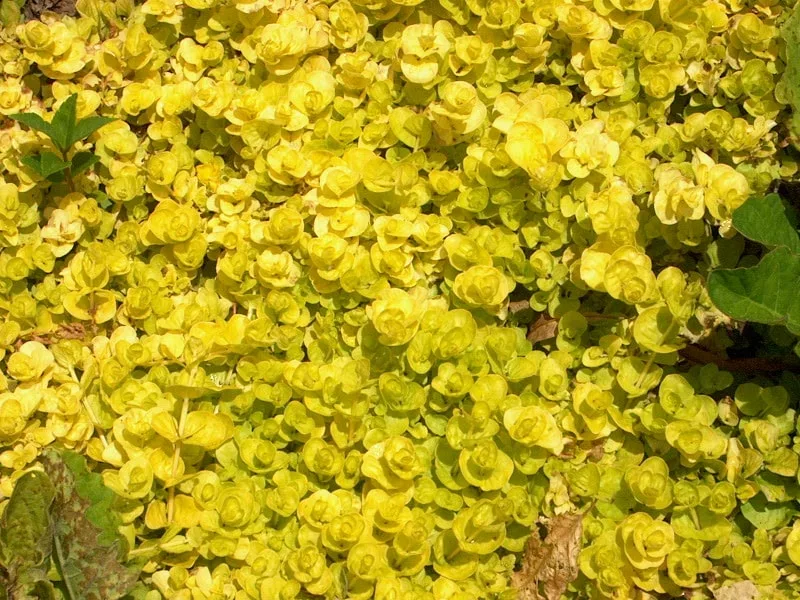
Various kinds of creeping jenny provide gorgeous ground coverage. Pictured, is bright yellow known by ‘Aurea.’ The one known by Lysimachia nummularia ‘green’ also has vibrant foliage but of a bright green shade of color.
The rounded leaves make this a popular ground cover that brightens the dark of any shade.
- Height: 3-6 inches.
- Range: Native to Europe.
- Climate: Zones 3-9.
- Functions: Ornamental ground cover flowering from June to August but provides attractive evergreen foliage. Low maintenance. Easy to grow.
- Light requirements: Partial shade is preferred. Also grows well in bright full shade. Tolerates dense full shade and will grow toward brighter areas.
- Soil preferences: Moist, boggy, or wet soil. Suitable for heavy clay.
Potted plants or seeds are available.
Hosta (Hosta spp.)
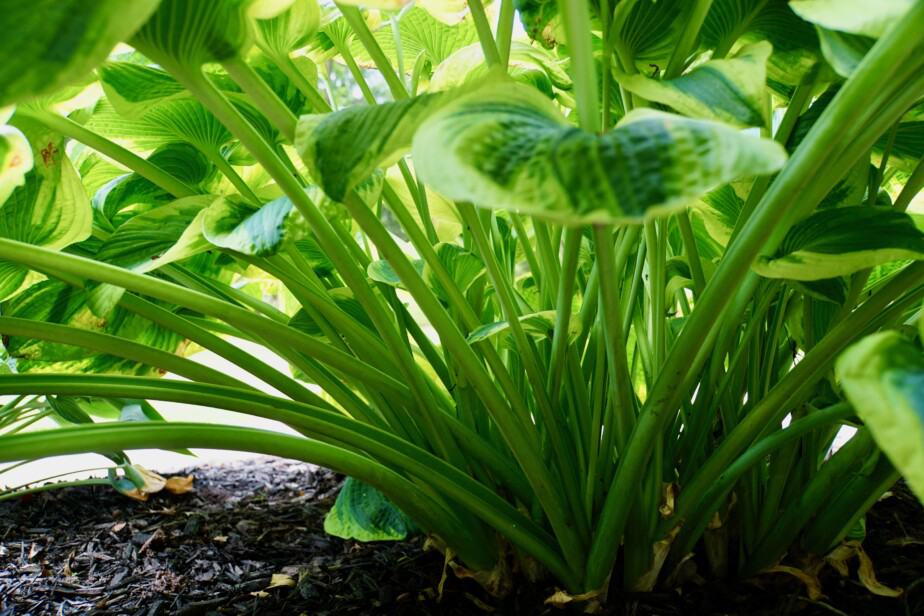
Hundreds of hosta varieties come in various sizes and foliage colors, and all are perfect for shaded areas.
- Height: Most common height range is between 1-3 feet depending on the type chosen.
- Range: Native to Asia.
- Climate: Zones 3-9.
- Functions: Ornamental ground cover with gorgeous foliage. Edible (tasty) spring shoots. Easy to grow. Low maintenance. A trap to draw slugs or snails.
- Light requirements: Prefers partial shade to Full or deep shade.
- Soil preferences: Moist soil. Suitable for heavy clay or sand when rich with humus.
Cold hardy hostas are available here and here.
Ostrich fern (Matteuccia struthiopteris)
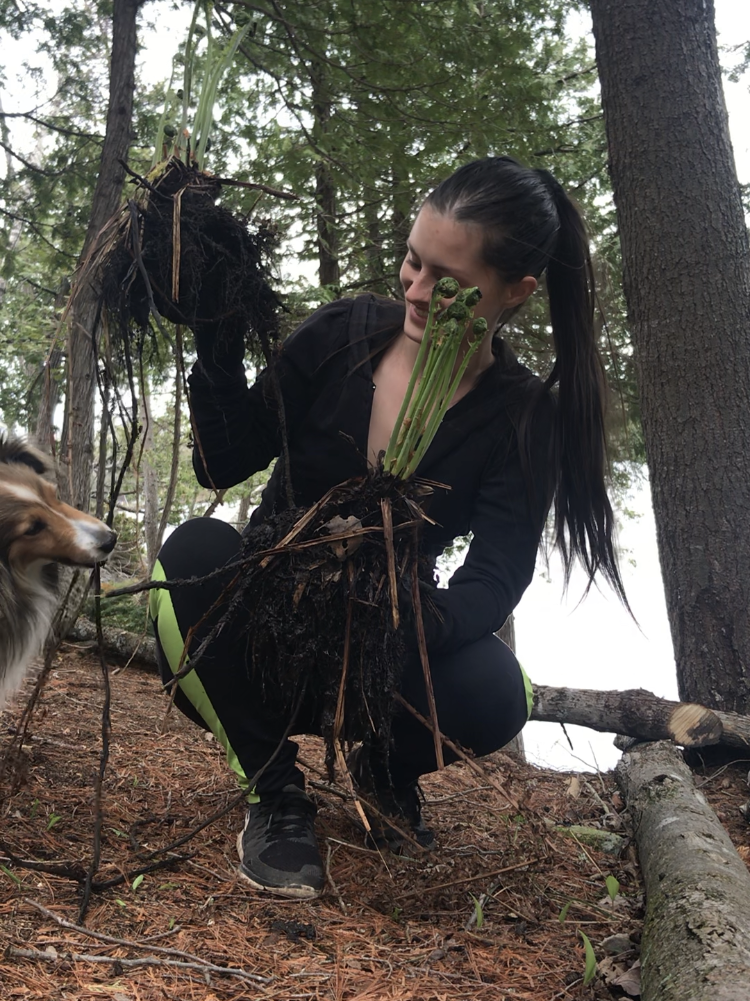
Also known as fiddlehead fern or fiddleheads! The ‘fiddleheads’ are deliciously edible in early spring while young and unfurled. Pictured, is me holding our ostrich ferns that we transplanted into our garden. The unfurled leaves are slightly past prime for consumption.
- Height: Grows up to 1-3ft.
- Range: North America, Europe, North Asia
- Climate: Zones 2-7
- Functions: Edible. Gorgeous ornamental. Excellent ground cover.
- Light requirements: Partial shade to full or deep shade.
- Soil preferences: Well-drained, moist, boggy, or wet soil. Suitable for heavy clay.
Ostrich fern plants or seeds are available here and here.
Related: 24 Best Edible Ground Covers for Shade
Maidenhair fern (Adiantum)
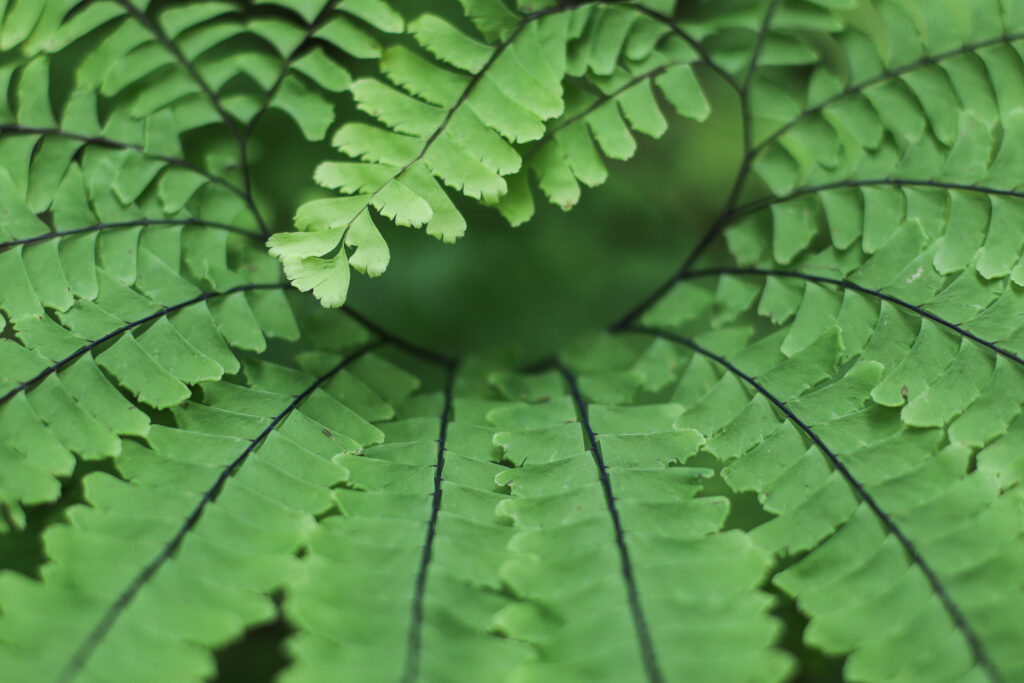
Maidenhair ferns have a delicate appeal to their foliage. If you love ferns for the looks, consider having a few types in a mix!
- Height: 1-2ft.
- Range: North America and Asia.
- Climate: Zones 3-9.
- Functions: Ornamental ground cover. Has been used as an accent to craft such as basketry.
- Light requirements: Full shade to partial shade.
- Soil preferences: Moist soil
Self-Heal (Prunella vulgaris)
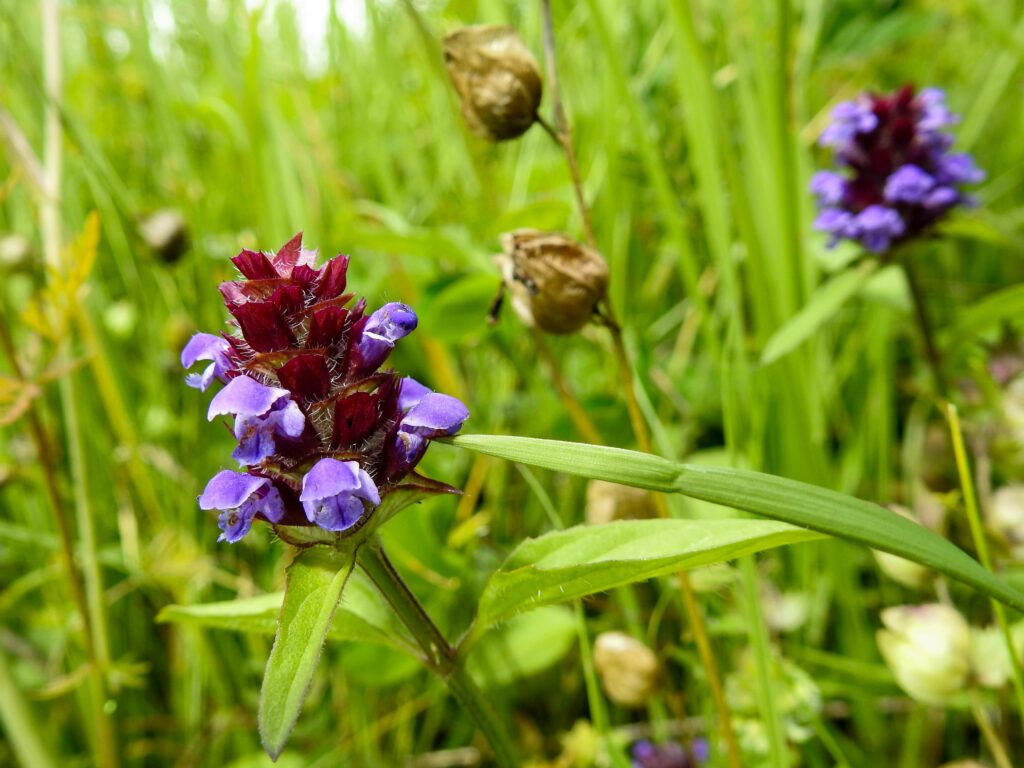
We grow and collect the flowers of self-heal for a nourishing tea. The taste is quite pleasant with sweet notes. The plant is also cute-looking with pretty purple flowers.
- Height: 2-6 inches.
- Range: Native to temperate climates in Europe, North Africa, and Asia.
- Climate: Zones 3-7.
- Functions: Attracts pollinators such as bees. Medicinal qualities have been described to accelerate wound healing, fevers, and more. Edible for salads or tea. Small and cute looking. Ideal for high-functioning forest gardens.
- Light requirements: Partial shade to shade.
- Soil preferences: Moist soil.
Labrador Violet (Viola labradorica)
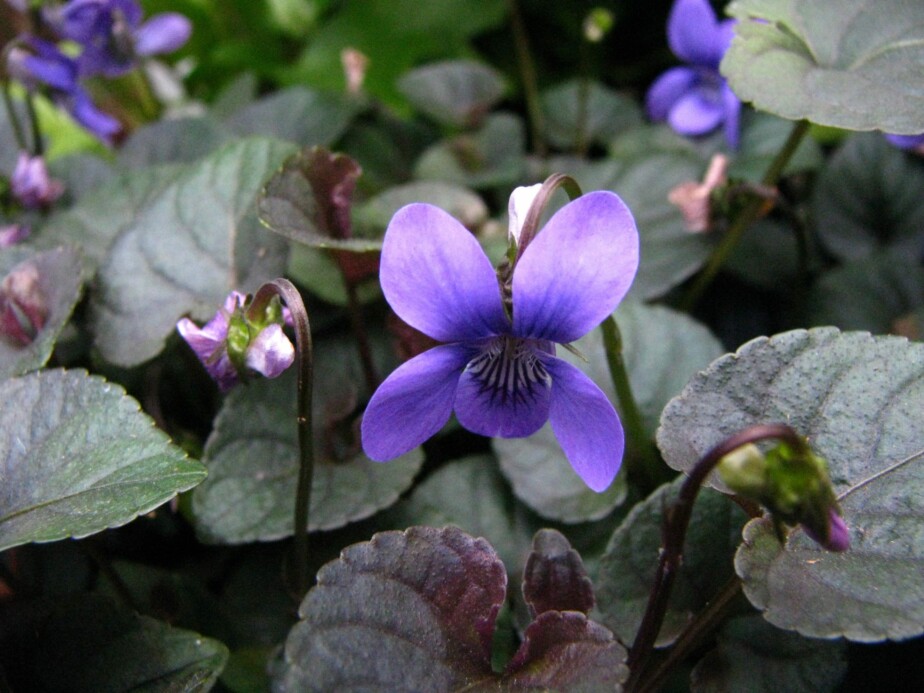
With their contrasting dark foliage, labrador violets are typically used as borders in rock gardens, food forests, or general woodland/wild gardens.
- Height: 3-4 inches.
- Range: Native to North America.
- Climate: Zones 3-8.
- Functions: Ornamental borders. Attracting butterflies. Edible flowers and leaves for salad, cooked greens, or tea.
- Light requirements: Full dense shade to partial shade.
- Soil preferences: Moist
Seeds are available here on Etsy.
Bergenia (Bergenia cordifolia)
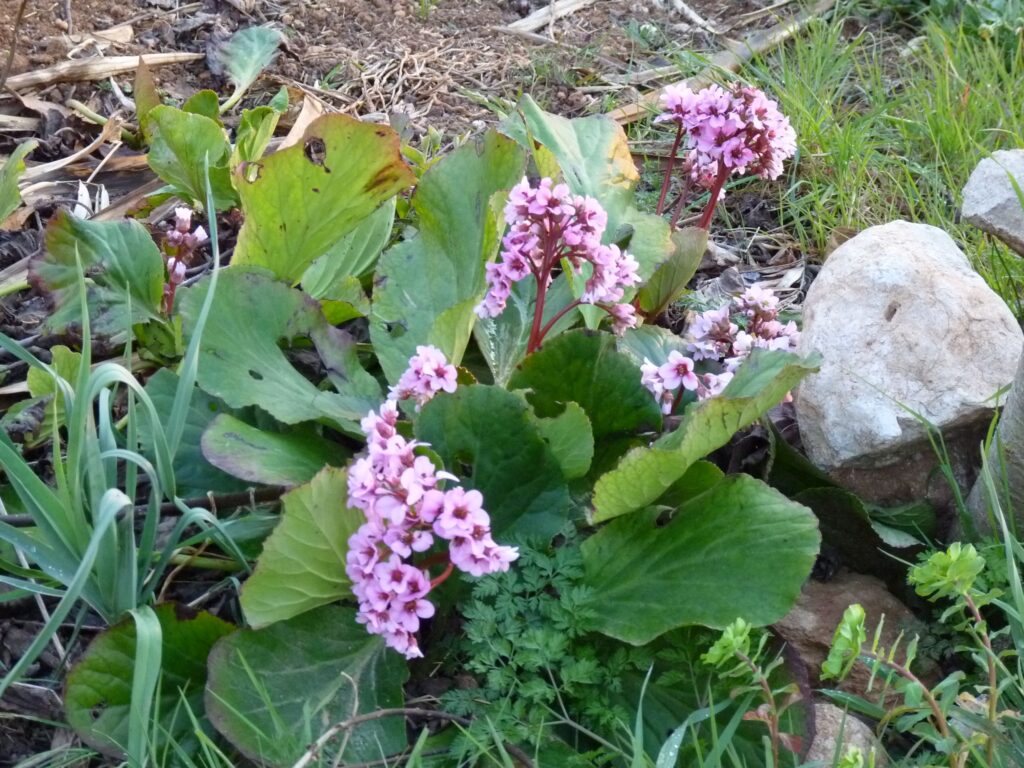
Also known as Elephant’s Ears, bergenia has large, leathery leaves and clusters of pink or white flowers.
- Height: 6-12 inches.
- Range: Eastern Asia.
- Climate: Zones 3-9.
- Functions: Early ornamental evergreen foliage all year and flowers from March to May. Ideal for ornamental gardens for a variety of flowers and blooming times.
- Light requirements: Full or deep shade, partial shade, or full sun.
- Soil preferences: Moist soil, but tolerates drought. Suitable for heavy clay.
Seeds and plants are available here.
Related: 12 Shade-loving Ground Covers for Droughts & Low Effort
Moss phlox (Phlox subulata)
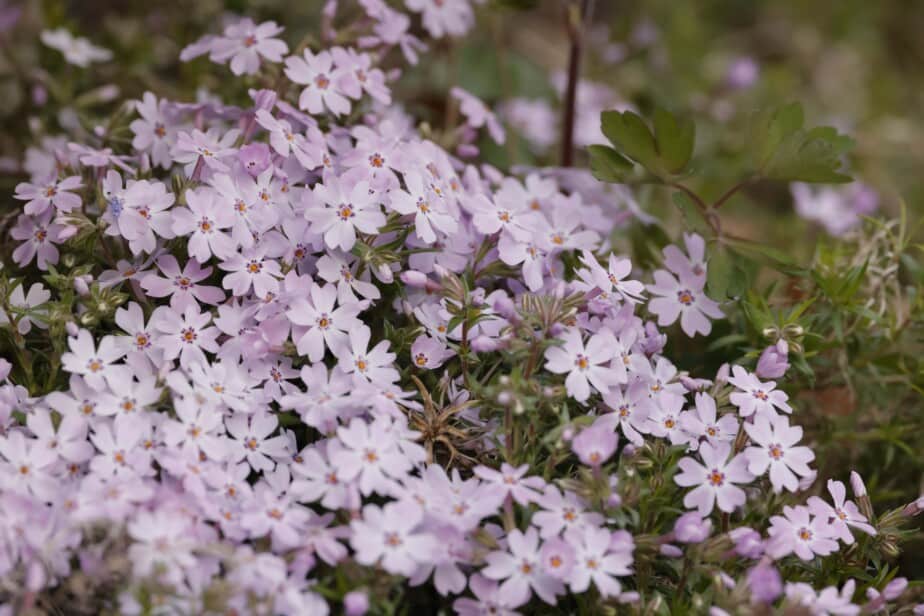
Moss phlox is a popular flowering ground cover as it’s highly adaptable to various conditions, grows fast, and looks great.
- Height: 4-6 inches.
- Range: Native to North America
- Climate: Zone 3-9
- Functions: Erosion control. Soil building. dense ground coverage. Ornamental flowers from April to May.
- Light requirements: Partial shade to light shade or full sun.
- Soil preferences: Dry or moist soil
A wide variety of colors to choose from here.
Small solomons seal (Polygonatum biflorum)
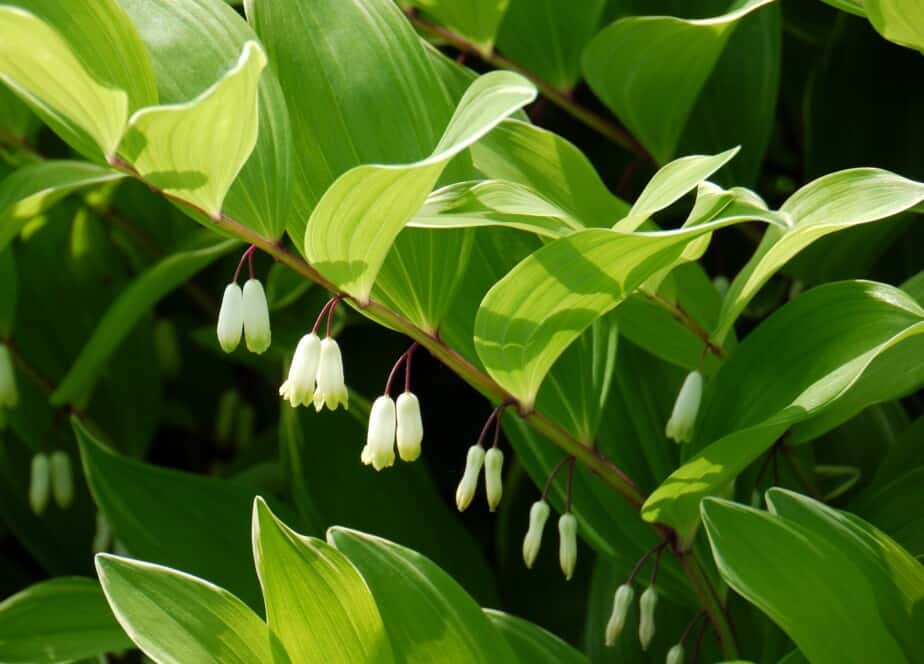
Solomon’s seal is a popular native ground cover for food forests. More gardeners are planting them for their ornamental value as well.
- Height: 3 feet
- Range: North America
- Climate: Zones 3-7
- Functions: Ornamental. Edible leaves, roots, and shoots. Ideal for adding diversity to a forest garden’s ground cover layer. Trap for slugs.
- Light requirements: Full/deep shade to partial shade.
- Soil preferences: Moist soil
Polygonatum biflorum variety is currently available here.
Snowdrop anemone (Anemone sylvestris)
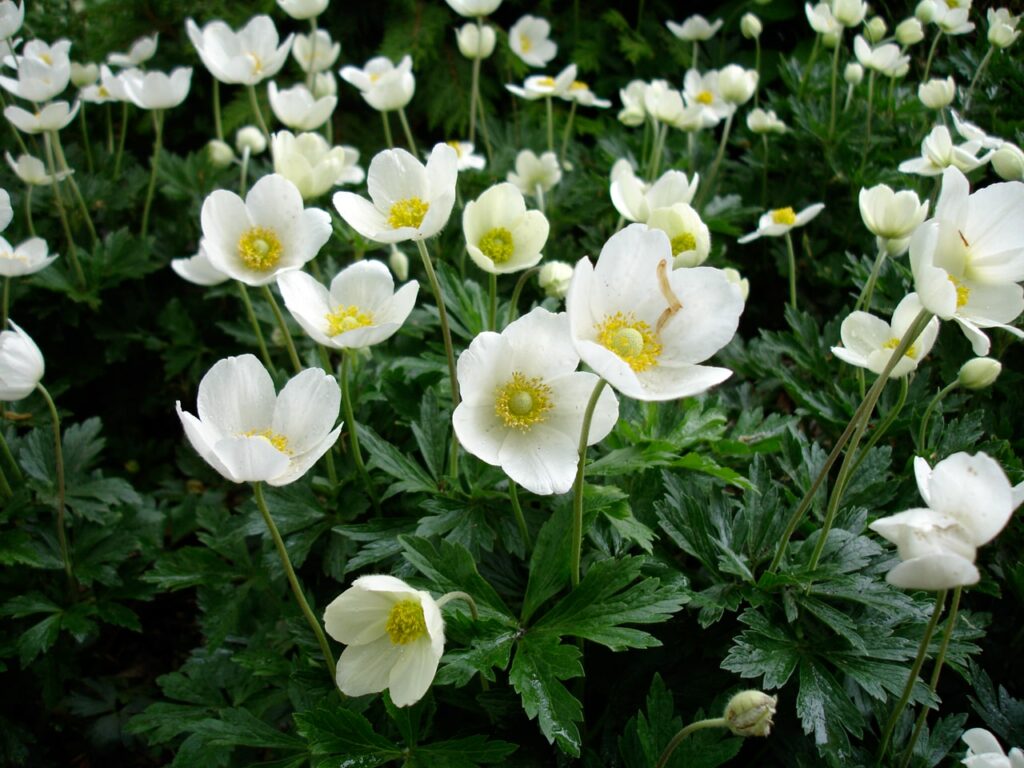
Lush carpeting dark-green foliage makes a perfect ground cover with early bright white blooms.
- Height: 12-24 inches.
- Range: Asia and Europe.
- Climate: Zone 3-8
- Functions: Easy to grow ground cover. Attractive and ornamental.
- Light requirements: Full shade to partial shade.
- Soil preferences: Well-drained soils
Seeds or plants are available here.
Related: 15 Easiest Ground Covers that Thrive in Shade
Pink Pewter (lamium maculatum)
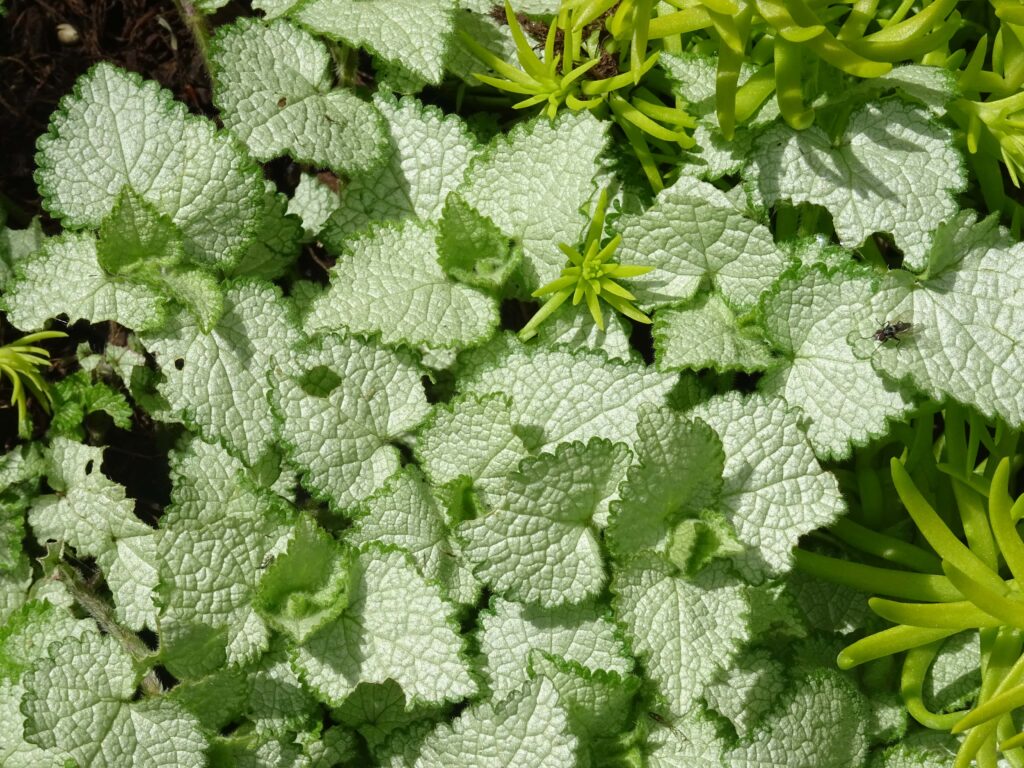
Often planted as a ground cover to border beds or below perennials shrubs and trees. Attractive silver foliage is outlined with darker green edges.
- Height: 6-8 inches.
- Range: Asia and Europe.
- Climate: Zone 3-8
- Functions: Easy to grow ground cover. Pest resistant. Attractive and ornamental.
- Light requirements: Full shade to partial shade.
- Soil preferences: Well-drained soils and drought tolerant.
Plants and seeds are available here.
Bugleweed (Ajuga reptans)
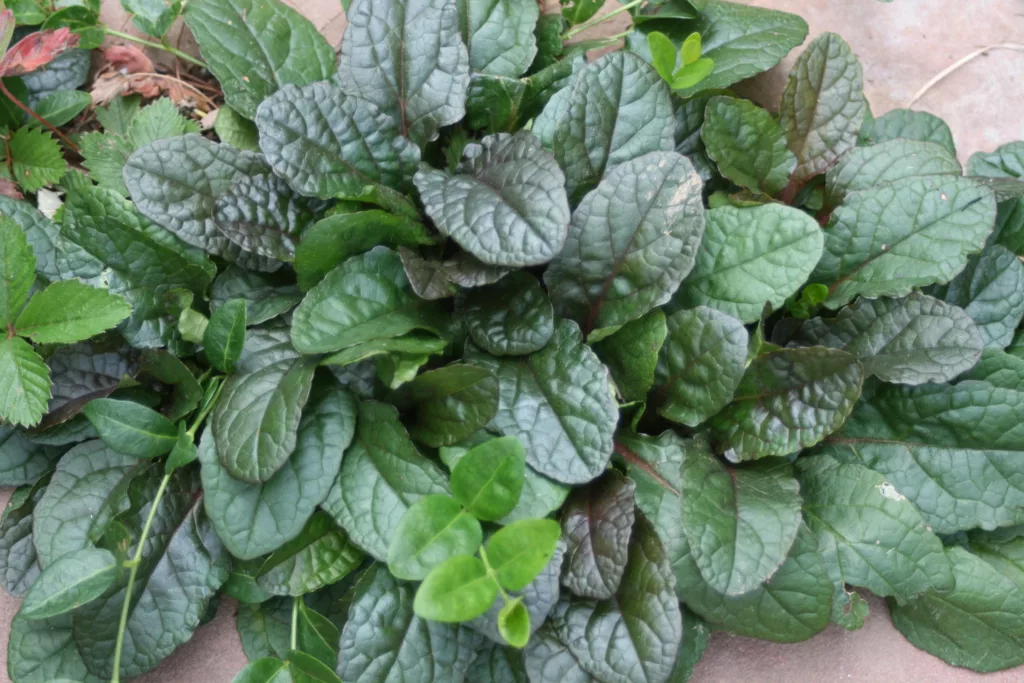
Also known as Bugleweed, it forms a dense mat with spikes of blue flowers. It has small creeping foliage and keeps snug to the ground.
- Height: 4-8 inches.
- Range: Europe, Asia, North Africa.
- Climate: Zones 3-10
- Functions: Attracts bees and butterflies. Edible leaves and shoots. Cute carpeting ground coverage. Medicinal benefits. Ideal for rock gardens, erosion control, low growing ground coverage, and usefulness.
- Light requirements: Full/deep shade to partial shade.
- Soil preferences: Moist or wet soil. Tolerates droughts.
Plants and seeds are available here.
Joe Pye weed (Eutrochium spp.)
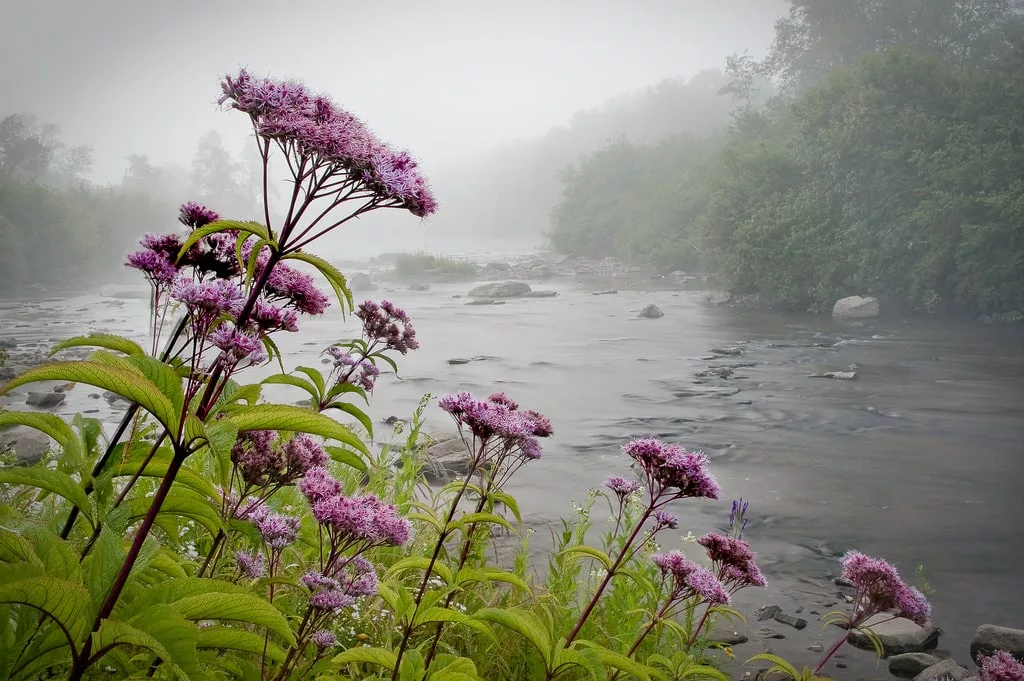
Joe Pye Weed is a popular North American Native for pollinators and humans as they cover a lot of ground by growing fast, tall, and wide.
- Height: 6-9 feet.
- Range: North America
- Climate: Zones 3-9
- Functions: Attracts and feeds pollinators. Ashes of burnt roots can be used for survival salt. Fragrant foliage.
- Light requirements: Partial shade.
- Soil preferences: Moist soil.
Various color options are available here by seed.
Lady’s mantle (Alchemilla mollis)
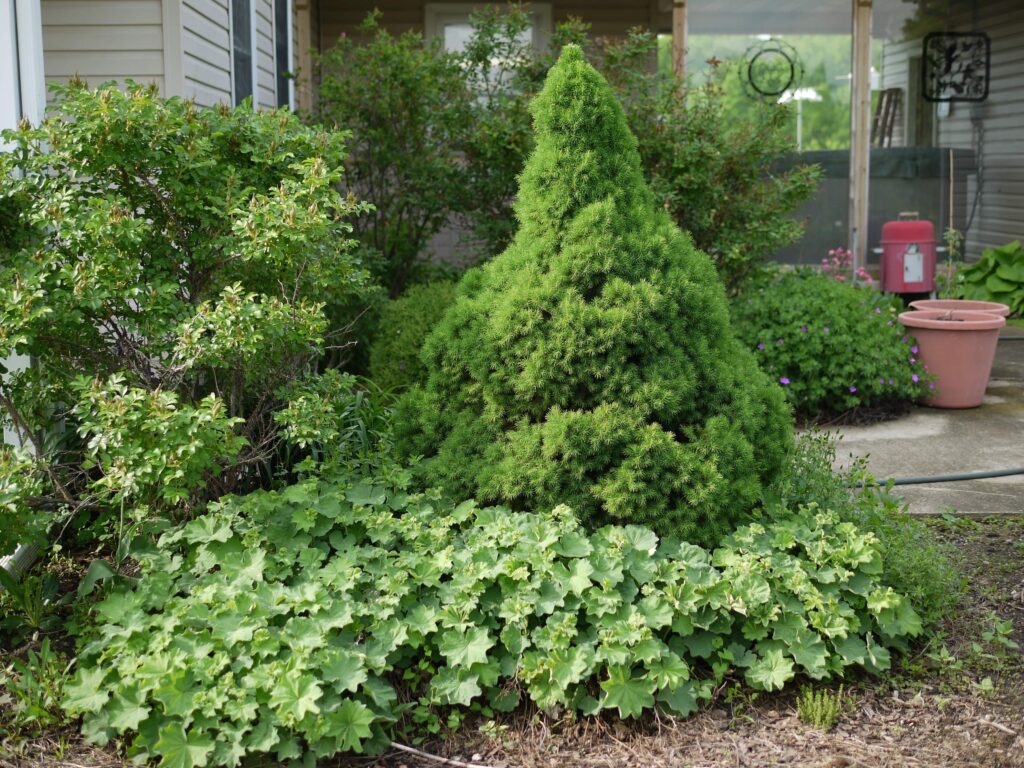
Lady’s mantle is loved by those who want a garden of texture! Their foliage resembles begonias but with less glossy more soft matte leaves.
- Height: 6-12 inches.
- Range: Europe.
- Climate: Zones 3-7
- Functions: Ornamental flowering from June to September.
- Light requirements: Full shade to partial shade.
- Soil preferences: Prefers dry or moist soil.
Seeds are available here.
Lily of the Valley (Convallaria majalis)
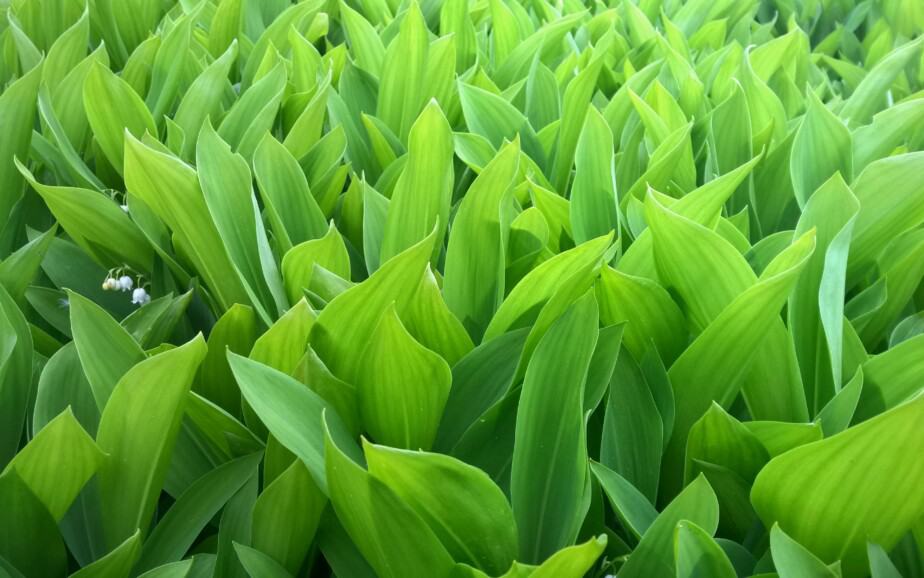
Shade-loving perennial with fragrant, bell-shaped flowers from May to June.
- Height: 6-12 inches.
- Range: Europe and Asia.
- Climate: zone 2-7.
- Functions: Ornamental with attractive foliage, dainty flowers, and pleasant fragrance but considered invasive in many areas.
- Light requirements: Full shade, partial shade, or full sun.
- Soil preferences: Easy to grow in various conditions—Dry, moist, or wet soil. Suitable for heavy clay.
Consider Solomon’s seal (mentioned above) if the lily of the valley is invasive in your area! Their foliage and flowers are somewhat similar. Seeds are available here.
Siberian Carpet Cypress (Microbiota decussata)
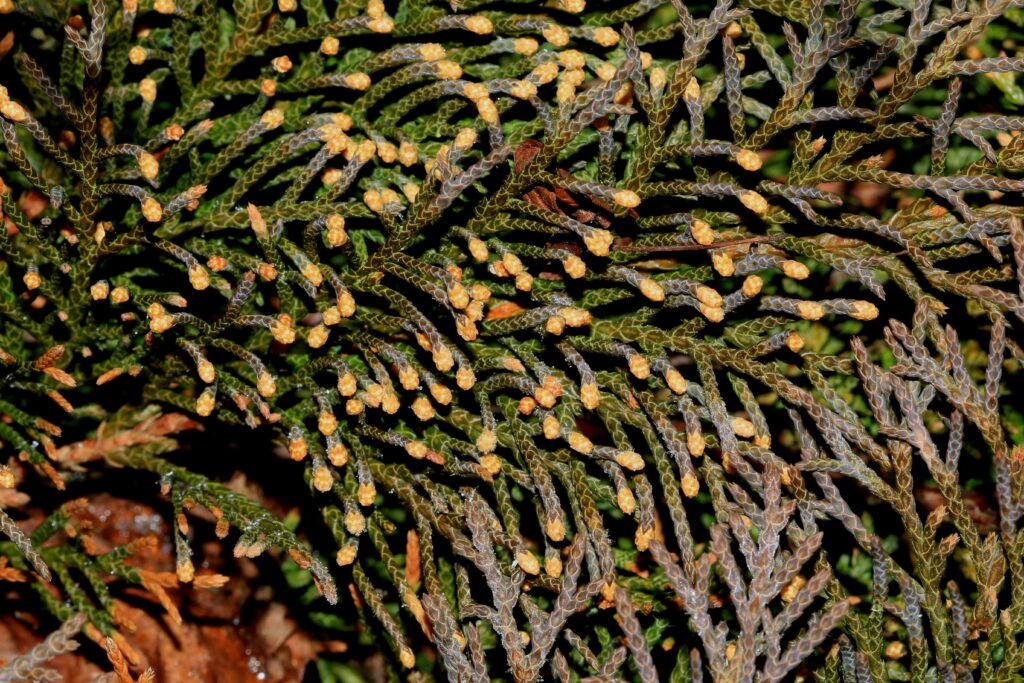
A soft coniferous ground cover with a dense and low growing habit makes a beautiful year-round evergreen ground cover.
- Height: 18-24 inches.
- Range: Eastern Siberia.
- Climate: Zones 2-8.
- Functions: Evergreen beauty.
- Light requirements: Partial shade.
- Soil preferences: Well-drained.
Plants are available at Nature Hills Nursery. Bookmark this to check back if it’s currently out of stock.
Related: 23 Evergreen Ground Covers for Shade
Pink Purslane (Claytonia sibirica)
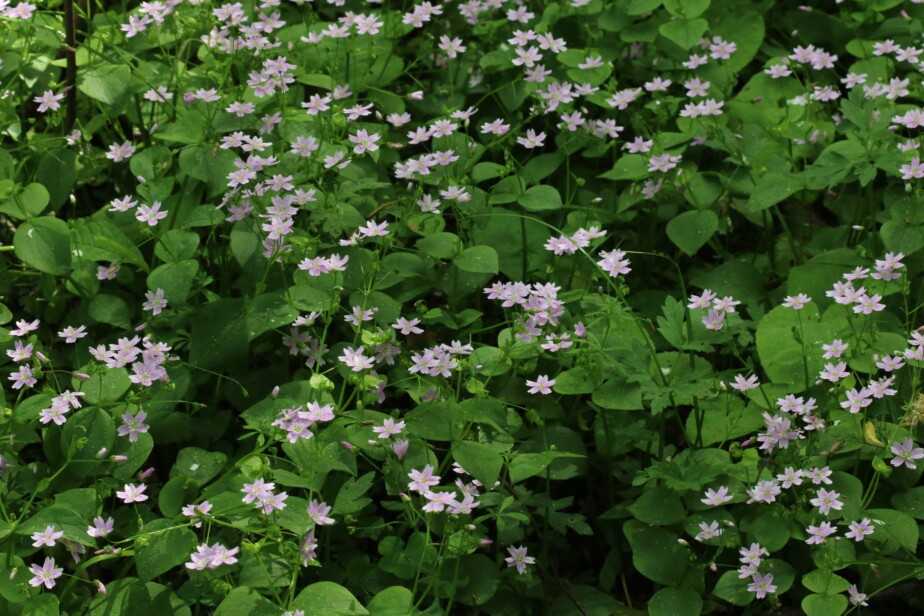
Purslane is a popular edible ground cover. The leaves are often consumed raw or as cooked greens and resemble sweet beetroots. The leaves are somewhat succulent and crunchy.
- Height: 4-8 inches.
- Range: Eastern Asia to Siberia. Western North America.
- Climate: Zones 3-7.
- Functions: Pretty pink flowers from April to July. Ideal for ground coverage in a forest garden. A very cold hardy edible green.
- Light requirements: Full shade to partial shade. Tolerates full sun but prefers some shade.
- Soil preferences: Dry or moist soil.
Seed available here.
Lingonberry (Vaccinium vitis-idaea)
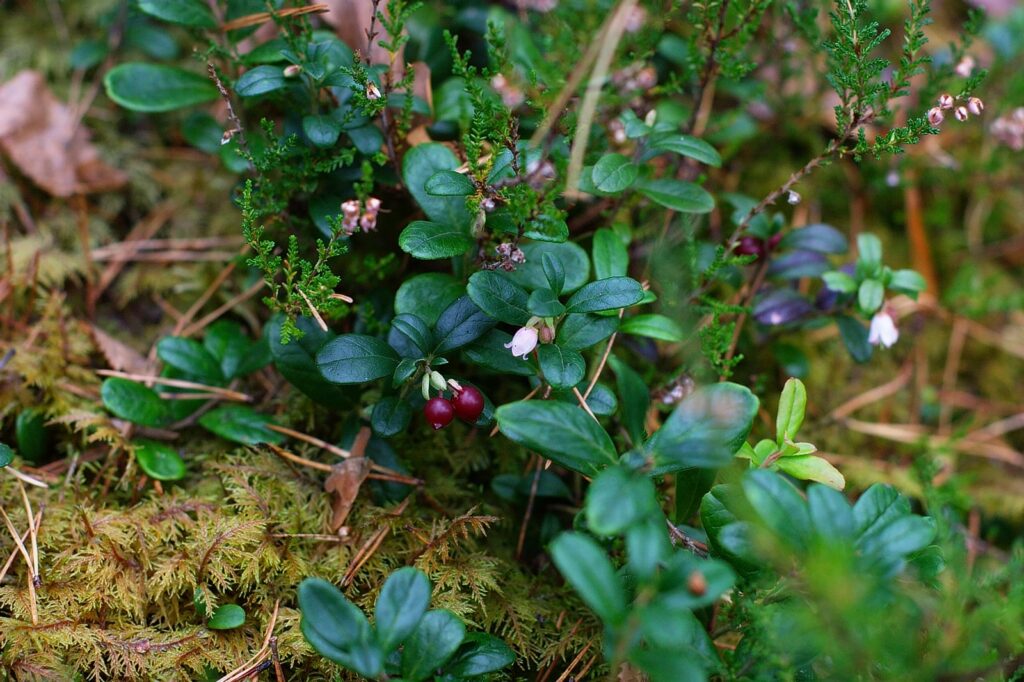
Lingonberry bushes produce edible red fruits similar to cranberries. The flowers are also very attractive to pollinators. This plant is a popular food forest ground cover.
- Height: 12-18 inches.
- Range: Europe and Asia.
- Climate: Zones 3-8.
- Functions: An ornamental and edible evergreen ground cover. Attract pollinators.
- Light requirements: Best in partial shade.
- Soil preferences: Moist soil.
Seeds to grow this precious shrub are available (surprise, surprise) here on Etsy.
Creeping Dogwood (Cornus canadensis)
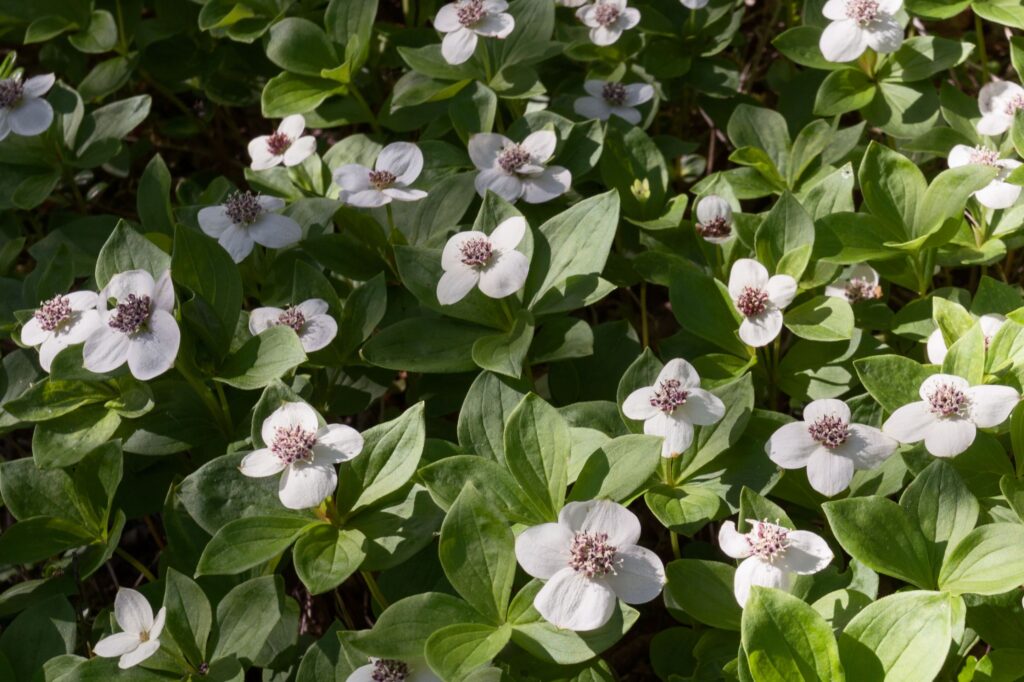
Also known as “bunchberry.” This plant produces edible fruit high in pectins.
- Height: 4-9 inches.
- Range: Native to North America.
- Climate: Zones 2-7.
- Functions: High in pectin for edible uses such as jams. Is used as a ground cover in food forests.
- Light requirements: shade or partial shade.
- Soil preferences: Suitable for heavy clay.
Seeds and cutting are available here.
Trailing Bellflower (Campanula poscharskyana)
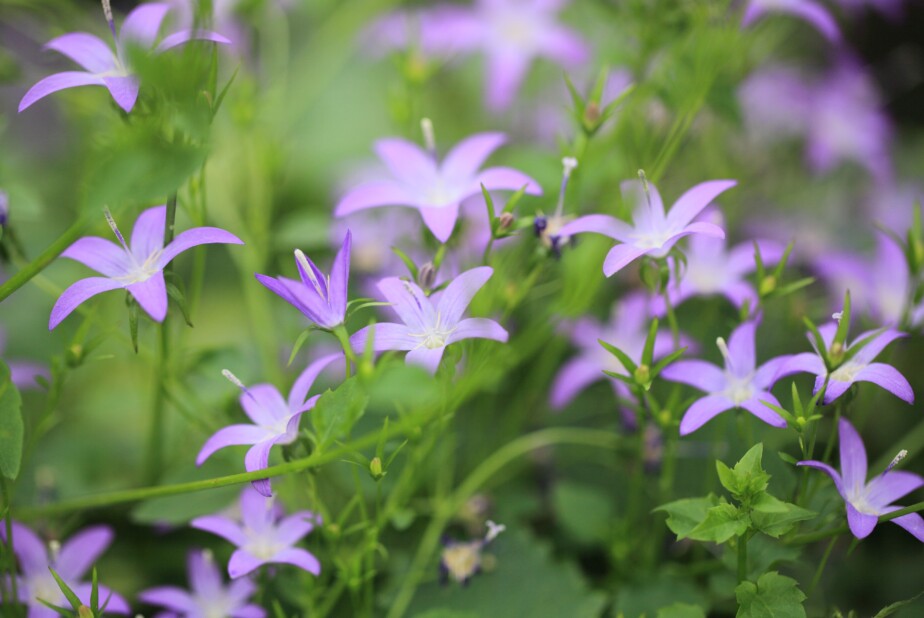
An edible and low-growing semi-evergreen plant with pretty purple flowers.
- Height: 4-10 inches.
- Range: Native to Europe.
- Climate: Zones 3-7.
- Functions: Attracting pollinators. Edible flowers and leaves. Dense ground coverage with blooms from June to August flowers.
- Light requirements: Partial shade is best.
- Soil preferences: Moist soil.
Seeds for white or purple flowers are available here.
Sweet Woodruff (Galium odoratum)

Sweet woodruff is a fragrant ground cover with an annual lifecycle. In our area, this plant freely and easily reseeds itself. You’ll find it pops up each year in the same spot and new spots as well.
- Height: 5-6 inches
- Range: Native to Europe and Asia
- Climate: Zones 3-7
- Functions: Fragrant. Food source for butterflies. Ornamental: attractive foliage and dainty white flowers from June to August. Best for ‘wild’ style gardens.
- Light requirements: Thrives in full shade, partial shade also works when sheltered from any hot sun.
- Soil preferences: Dry to moist soils with plenty of mulch
While lovely to look at, this plant does produce small burs when it goes to seed each year. The burs aren’t a terrible nuisance as they aren’t overly sticky or sharp like various native weeds. This plant is easy to get rid of if you ever want to. Simply cut it back when it goes to seed.
You can also control the spread by collecting its seeds before they
Seeds to plant sweet woodruff in your cold shady garden are available here on Etsy.
Wood sorrel (Oxalis acetosella)
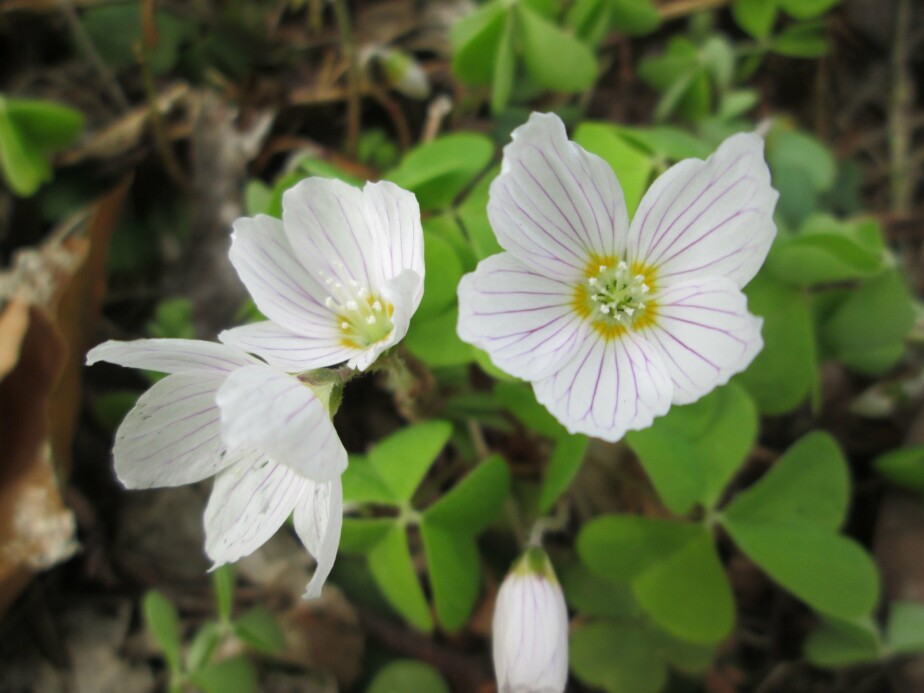
Wood sorrel naturally grows near wooded swamps or in moist shaded areas. Heavy clay and wet soils, however, are not a good environment. This plant is fast growing and fills in the gaps quickly.
- Height: 5-6 inches
- Range: Native to Europe and Asia
- Climate: Zones 3-7
- Functions: Ornamental: attractive foliage and delicate white flowers from April to May. Best for ornamental or ‘wild’ style gardens.
- Light requirements: Partial shade.
- Soil preferences: Moist and humus-rich soil.
Gourmet Mushrooms
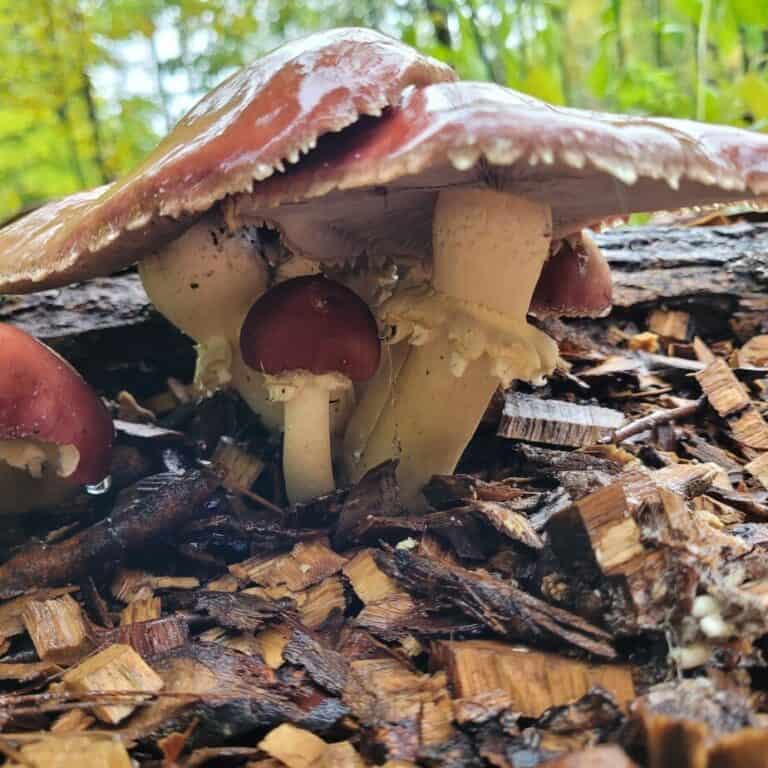
If you’re trying to fill shady spots with functional plants mushrooms also thrive in shade!
Fresh mushrooms grown from woodchips are deliciously edible and wood chips offer gorgeous ground coverage while you wait for dinner to spontaneously pop out of the ground.
See: 6 Best Mushrooms for Woodchip Beds
Recent Posts
There’s no shortage of full-sun ground covers for zone 4 climates! Each plant in this list can withstand the frigid temperatures and also enjoy the hot sun in summer. Full sun means that a plant...
There's no shortage of full sun ground covers, not even in zone 3! Zone 3 climates offer hot but short-lived summers and very cold winters. So each plant in this list can withstand the frigid...
